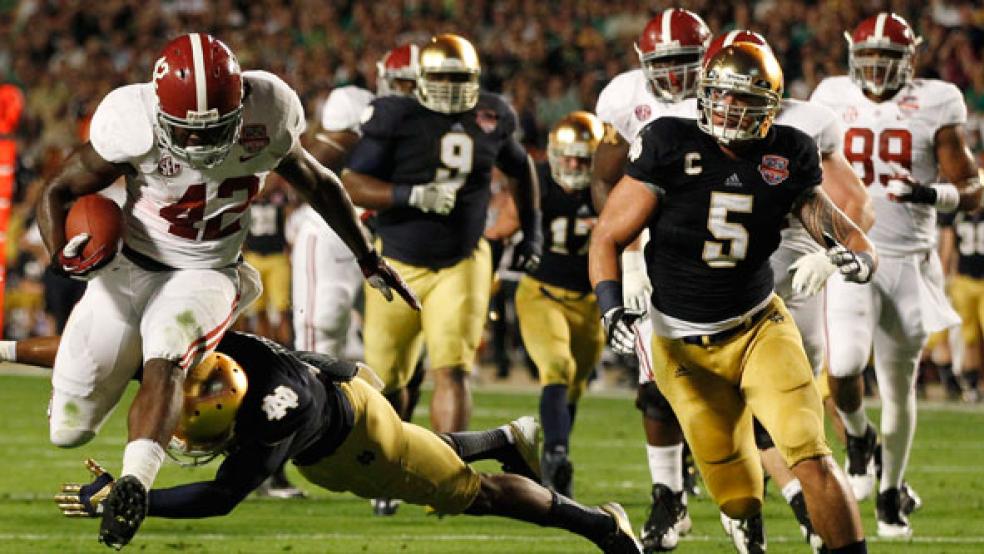“If this was a prize fight, they’d call it off.” That’s what announcer Brent Musburger said Monday night when it became clear Notre Dame was getting trounced by Alabama as the two storied teams squared off in the national collegiate football championship.
What’s at stake for these schools was a lot more than glory. Alabama, which crushed Notre Dame by a score of 42 to 14, walks away with $18 million; the ”Fighting Irish” at least limp home with the same amount. It took about 30 years for top college teams to get those big TV advertising dollars that fill the coffers of their schools. Operating under the umbrella of the National Collegiate Athletic Association – technically a non-profit association of more than 1,280 institutions, conferences and organizations – college football has evolved into a massive enterprise generating billions in annual television revenues, merchandising, jobs and economic activity, according to Andrew Zimbalist, a sports economist and professor at Smith College.
Top programs can generate tens of millions in revenue, with profits exceeding $30 million a year. The University of Texas, the most profitable of all college football programs, last year earned nearly $78 million on sales of almost $104 million. Alabama and Notre Dame each made more than $40 million for the 2011-12 season. And prospects are good that collegiate football may gradually eclipse professional football as an economic engine, due in part to a crucial business deal unveiled two years ago.
As the sport grows, though, it is widening a rift between schools like Alabama and a host of smaller colleges that will struggle to make up for lost money they once got as members of prominent athletic conferences. Some revenue from television contracts often goes toward academics, so as those smaller schools get left out of new deals, the impact could extend beyond the playing fields.
The reshaping of the college football world started in earnest two years ago. The University of Texas and ESPN announced on Jan. 19, 2011 that they would form a television network featuring programming focusing solely on UT sports. Under the terms of the deal, ESPN agreed to develop and launch what would eventually be called the Longhorn Network. Texas, a member of the Big 12 Conference, would be guaranteed $300 million over 20 years.
Shortly after the deal was announced, Texas A&M, realizing how difficult it would be compete against Texas for the state’s football talent, said it was leaving the Big 12 for the Southeastern Conference (SEC). The two teams had been rivals for the past 100 years, but under the new arrangements they are not likely to face each other again.
The Texas announcement and the subsequent move by Texas A&M sparked a radical transition for the NCAA, according to Daniel Fulks, an accounting professor at Transylvania University in Kentucky and a financial consultant to the NCAA. Long-standing member schools subsequently realigned themselves with new conferences in search of rich television payouts.
“That was the first big domino,” Fulks said of the Texas-ESPN deal. “All the conferences realized they could generate some money here with conference television contracts. It’s not about sports. It’s about business.” As the popularity of college sports grows, television contracts for leagues like the Big 12 and SEC will only get bigger, generating more and more revenue for member universities.
Zimbalist says that conference realignment is radically tipping the scales in favor of large universities at the expense of smaller institutions, which use a portion of the money from these contracts to finance their academic missions. Zimbalist also believes that the recent infusion of tens of millions of dollars into college sports will ultimately alter the way the NCAA operates.
“We’re moving to a situation with super conferences, and the outcome of these major television deals is a greater difference between the haves and have-nots,” Zimbalist said. “A lot of schools left behind will be unable to finance their athletic programs. It’s going to create pressure for change.”
Origins of Realignment
The realignment of the college football world has roots in a 1984 Supreme Court decision that struck down NCAA limitations on televised college football. Prior to the decision, networks could only air one or two games per weekend, typically based upon the popularity of the schools. After the decision, other networks began airing more games, giving viewers across the country television access to games they could previously only read about in the paper. In 1990, Notre Dame, signed a deal with NBC to air all of the school’s home games for $38 million over five years (the contract has since been renewed). At the same time, the SEC was growing in size, vastly expanding the geographic reach of the conference.
But this activity pales in comparison to the mad scramble that’s remade the college football map in recent years. In 2007, the Big 10 and Fox formed the Big Ten Network, broadcasting exclusive content from the conference. Last year, Notre Dame agreed to leave the Big East and join the Atlantic Coast Conference (ACC) in all sports except football (its football program remains the last prominent independent team). The University of Pittsburgh, Louisville University and Syracuse, all members of the Big East, also agreed to join the ACC. After these four schools defected, the seven Catholic schools in the Big East announced they were leaving the conference to form their own conference. When Texas A&M joined the SEC, it brought Missouri with it. The Big Ten, traditionally a Midwest conference, added the University of Maryland and Rutgers.
Brian Goff, an economist at Western Kentucky University and a contributor to The Sports Economist blog, says all of these moves are motivated by one thing: the money that comes from a football television contract. The numbers back up Goff’s assertion. The ACC currently has a $3.6 billion, 15-year deal with ESPN, with each school receiving $17.1 million. The SEC has a $2.25 billion deal with ESPN, and an $825 million deal with CBS to air one game every week. Each school receives $17.1 billion, but now that Texas A&M and Missouri have joined the contracts with ESPN and CBS are expected to be renegotiated.
These huge numbers are also behind the strange geography of college conferences. In the past, schools in close physical proximity to one another formed leagues. Now, traditional regional rivalries, such as the “Backyard Brawl,” the annual game between Pitt and West Virginia, will likely disappear. Fulks, the accounting professor, says leagues are agreeing to accept schools with no geographic relation in an effort to expand their television market and drive up the cost of future TV contracts.
Winners and Losers
Conference realignment was a financial boon to the big schools involved. The soaring cost of television contracts are an obvious benefit to member schools – as the size of the contract increases, so does the amount each school receives. This allows these schools to not only grow their football program, but to support other sports that don’t generate revenue, as well as support these schools’ academic endeavors..
But this shift is a negative for smaller schools being left out of the realignment process. Take Villanova University, a Catholic school in suburban Philadelphia, for instance. With the Big East on the verge of breakup, Villanova is set to join the yet-unnamed Catholic league. Unless the new league lands a big contract, the school will receive a much smaller payout than the $1.56 million it had been getting. This means less money for athletic programs and fewer staff to support athletes.
The other obvious losers are the athletes who make these television contracts so lucrative. While some head coaches make millions of dollars – Alabama’s head coach Nick Saban will be paid $5.62 million this year - college athletes are forbidden from accepting money or performance-based rewards other than athletic scholarships. As the business of college football continues to grow, though, that might change. Raymond Sauer, a professor of economics at Clemson University, says that he believes the NCAA is evolving toward exploring some type of compensation system beyond scholarships.
A group of former collegiate athletes is suing the NCAA, claiming that it is violating antitrust law by licensing their names and likenesses without permission and without paying them. The plaintiffs are looking to expand their suit to include current student athletes and get certified as a class action. In October, a judge ordered ESPN to provide the group with its television and licensing contracts for Division 1 college football and basketball. The NCAA rejects the claims made in the suit and is fighting the case, which could go to trial next month. Depending on the outcome, financial factors could once again create upheaval in the world of college football.





